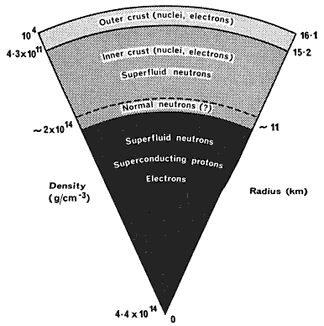In order to understand neutron stars we need to investigate the very extremes of physics, well beyond what can be achieved in the laboratory.
First of all, neutron stars are remarkably compact. Inside a radius of only ten kilometers is packed one and a half times the mass of our sun (the radius of which is 700 000 km)! The state of matter at such extreme densities is not at all well understood. The simplest picture of a neutron star as a `ball of fluid' in which neutron degeneracy pressure balances the pull of gravity (in a way similar to the electron degeneracy that supports a white dwarf), is not at all accurate. In reality a neutron star is more like a layer cake.
While the outer layers of a neutron star are made up of quite normal nuclei (mainly iron) the core fluid may exhibit much more exotic phases of matter. Experimental data from nuclear physics tells us that neutrons begin to `drip' out of the nuclei at roughly 1/1000 of the density on a typical nucleus.This would happen very close to the surface of a neutron star. Outside the point of neutron drip, the star is composed of a lattice of nuclei on top of which may be a very shallow ocean (perhaps a few hundred meters deep). As we approach the centre of the star we pass through what is known as the inner crust, a region in which the more or less solid lattice coexists with a fluid composed of neutrons, protons and electrons. This region extends for perhaps 1 km in all but very young neutron stars. As we reach roughly nuclear density the crust gives way to the fluid core, the details of which are not well known. Key elements, are likely to include a neutron superfluid, exotic particles like hyperons, possible pion/kaon condensates and perhaps even a quark-gluon plasma in the very neutron star core. Clearly, neutron stars provide many challenges for both theorists and observers.
 |
It is generally expected that the neutrons become superfluid in all but the very youngest neutron stars. At the same time the protons may form a type II superconductor. Many models for the glitches observed in pulsars are based on the notion of a sudden transfer of angular momentum from the superfluid neutrons to the crust. |
In recent years it has been suggested that compact stars come in many different flavours, some of which are quite different from the `standard' neutron star. So for example has it been suggested that stars entirely made up of strange, up and down quarks exist. Speculations of such `strange stars' followed Ed Witten's suggestion that strange matter would be the most stable form of matter in the universe. This is a very exciting idea, but it turns out that it would be very difficult to distinguish a strange star from a neutron star. The main reason for this is that, even though strange stars are held together by both the strong force and gravity it turns out that at a mass of one and a half solar mass gravity dominates and such strange stars would therefore have the same size as a neutron star. Furthermore, the strange stars may be hard to find because they hide inside a thin crust of `normal' matter. Given these difficulties we have as yet no clear evidence that strange stars exist.
Another class of exotic compact stars are the `magnetars'. These are neutron stars which have extreme magnetic fields. The magnetars would have magnetic fields some 1000 times stronger than those of typical radio pulsars. In the last few years the evidence for the existence of magnetars has been mounting. It is now generally believed that both the so-called Soft Gamma repeaters (which exhibit occasional gamma ray bursts) and the anomalous X-ray pulsars are magnetars. All these stars spin very slowly compared to the standard radio pulsar. The explanation for this would simply be that, even though they may be born spinning fast, magnetars undergo rapid magnetic braking and slow down to a spin period of second in maybe 1000 years. In comparison, the Crab pulsar which was likely born rotating with a period of about 19 ms has only spun down to 33 ms since its birth in 1054.
| An artists impression of a Soft-Gamma Repeater. A rotating magnetar spins down rapidly due to extreme magnetic braking. As its crusts cracks it undergoes a starquake and the violent shaking of the magnetic field lines lead to a gamma-ray burst. |